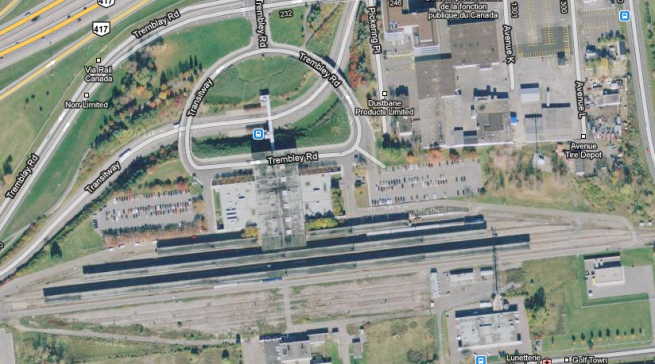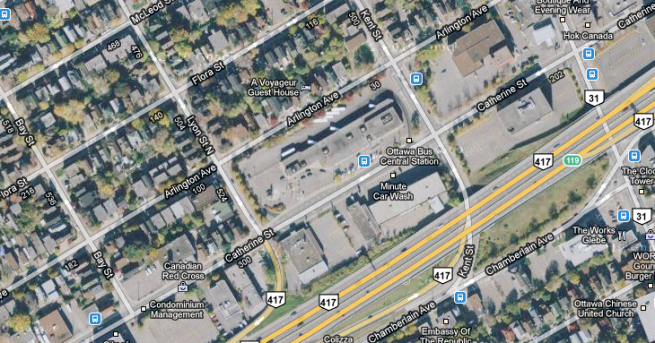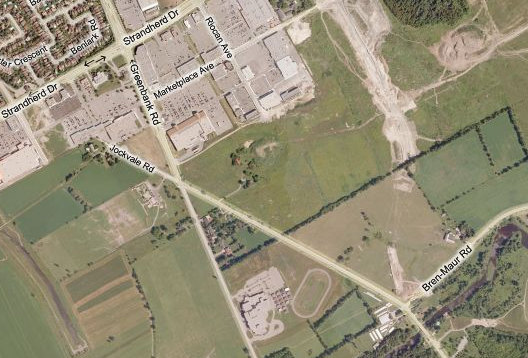Even if you’ve been doing nothing but glimpse at the headlines of Ottawa’s major dailies, you doubtless know about the “rising” costs of the City’s light rail plans. With the first phase projected to top $2 billion, the province is starting to get cold feet over helping to fund the project, and it seems like many people are getting antsy over exactly how much the City will have to shell out to get things done.
Others have already done an excellent job of deconstructing the numbers that are floating around, showing that things may not be as bad as they seem, but the fact remains: the plan is now percieved as being too expensive. Regardless of the plan’s actual value and cost-effectiveness, it’s possible that it will need to be scaled down in order to secure funding from higher levels of government. So my thought is, why not a combined surface and underground system in the downtown core? Here’s a map I threw together:

Blue is surface rail, red is tunneled. Train symbols represent potential stations. Map created using Google Maps.
In this proposal, rail would follow the Transitway to Lebreton, where it would divert north along the current alignment of Wellington Street—currently used for tour bus parking, I believe—before diving underground for a short tunneled section at Commissioner Street. A slight curve under Bronson Park would line the rail up with Sparks Street, where it would come aboveground just after Bay. From there, it would run along Sparks with stops at Lyon, Bank, and Metcalfe, before diving back underground to curve around to Mackenzie King and Campus stations.
Before I go on, I should say that this is entirely conjecture. I’m not certain if any of these curves or climbs would actually work for LRT vehicles, it just seemed like the most logical way to do things at the time.
I think there would be a number of advantages to this idea. Most notably, it would remove nearly a kilometre of tunnel, which, at a guess, would probably shave $60–70 million off the bill, along with allowing for surface stations instead of underground stops, also representing a significant savings. Furthermore, I chose Sparks Street for the surface section for a reason: having trains running along that corridor would do a lot to improve the liveliness of that half-abandoned pedestrian mall, giving people a reason to be there outside of office workers on their lunch breaks.
Of course, there would be obstacles. The National Capital Commission would of course be reluctant to allow trains on Sparks, something that would need to be heavily negotiated. And it still wouldn’t be cheap, just somewhat less-expensive, so it would hopefully be more palatable to the McGuinty government.
Sparks is not the only option for surface rail, either. Albert and Slater could theoretically be used, as they are now, however I think it would be difficult to remove the need for tunneled sections entirely. If the current Transitway lanes were used, leading to the Mackenzie King Bridge, then an extremely tight turn would be required to align trains up for the run to Campus station. Either a tunnel would be needed to make a more gradual turn, or a serious reconstruction of the area around the east end of the bridge would be necessary.
In all, while it would require a lot of work and a lot of inter-agency co-operation, I think Sparks Street is the most logical place to build a section of surface rail, if we decide it’s neccessary to reduce the plans cost. At this point, I think it would be premature to scrap the current tunnel plan entirely, but it is at least worth considering our alternatives.








Does Terry Fox Drive really need extending?
Tags: development, environment, news and comment, Ottawa politics, proposals, sprawl, suburban vs. urban, the future
As I browsed through the Ottawa Citizen yesterday, I couldn’t help but notice this article, on the extension of Kanata’s Terry Fox Drive being fast-tracked despite a number of environmental concerns. I instantly knew I had to look it up and attempt to understand why it’s so important this particular project has to be pushed through and I came away baffled.
Helpfully, the extension already seems to be marked on Google Maps, so it was easy to get an idea for what the new roadway would look like. As described in the article, it will arc through forest, marsh, and farmland as it makes it’s way from the neighborhood of Kanata Lakes to Morgan’s Grant. And so far as I can tell, it will serve no useful purpose besides creating sprawl and potentially destroying a rare habitat. Not good, to say the least.
The endangered Blanding's Turtle, which can be found in marshland west of Kanata. Image from Canadian Wildlife Service, by Ryan M. Bolton.
I think what we have here is a case of the Greenbelt doing more harm than good for the environment. While I’d rather see the urban boundries of Ottawa’s suburbs frozen where they are for the time being, for growth to be concentrated inwards, it would seem to me that if Kanata has to expand, there are far more suitable areas to the east. There’s a lot of farmland out there, especially north of the 417, land that is for some reason protected, while the land to the west is not. While I hardly advocate paving over farmland for suburbia, it can’t be denied that there is a lot more of it around Ottawa compared to rare turtle habitats.
What strikes me about this is that we seem to have some very screwed-up priorities here. Is it really this important to build a shiny, four-lane monument to urban sprawl? Surely there must be some other piece of infrastructure that this stimulus money can be spent on—something that won’t harm an endangered species. That’d be something I could go for.